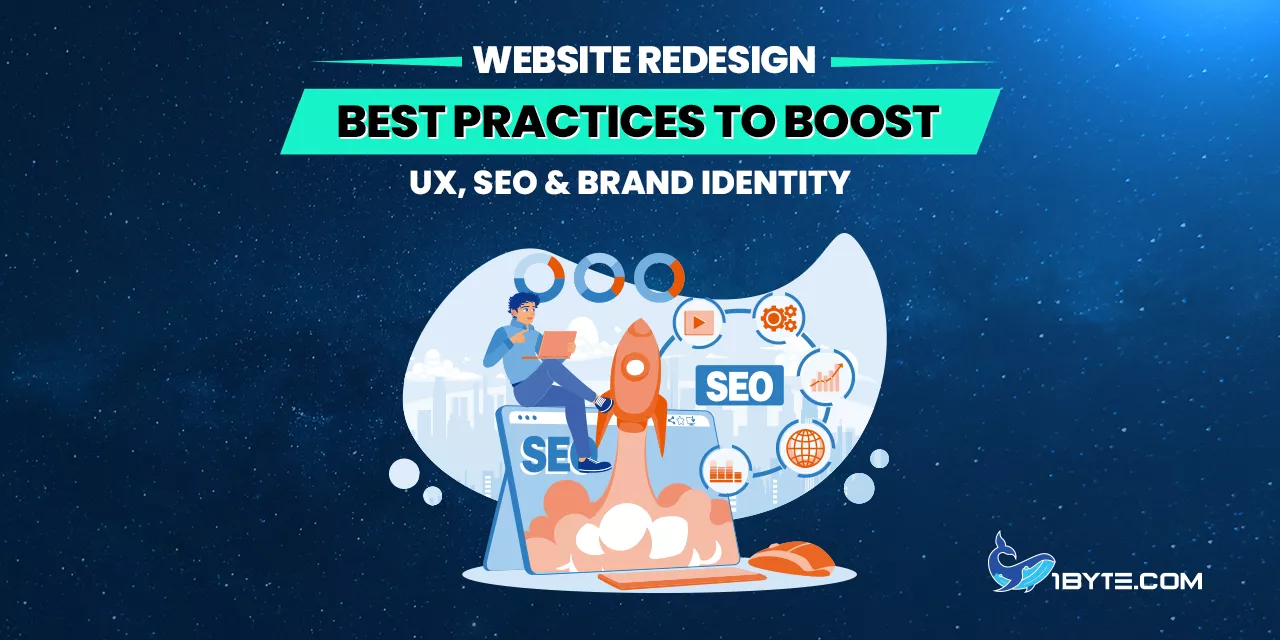- Why A Redesign Becomes Necessary
- The Numbers Behind Design, UX and Conversion
- Designing for User Experience
- Integrating SEO into the Redesign
- Aligning the Redesign with Brand Identity
- A Structured Process for A Website Redesign
- Real‑world Examples of Effective Redesigns
- Common Pitfalls and How To Avoid Them
- Conclusion
Website is a dynamic online resource. It requires attention and modification since the expectations of the users have a short lifespan. There are numerous companies using pages that were developed several years earlier. The antique designs may damage trust and profitability since in 0.05 seconds visitors create a judgement. First impressions are important since 75 percent of the population considers design to determine the credibility of a company. An outdated layout can be taken to mean an outdated business. A website redesign aligns your site with current technology, user experience (UX) standards, search engine optimisation (SEO) requirements and brand identity. This 1Byte article will include data-based recommendations, actionable steps and life examples to assist every brand to design a successful redesign.

Why A Redesign Becomes Necessary
Several factors compel businesses to overhaul their sites. Research shows that most visitors will not return after a poor experience. More than half of mobile users leave if a page takes longer than three seconds to load. Users expect pages to load in less than two seconds, and a one‑second delay can reduce conversions by up to 20 %. Slow pages also harm SEO because bounce rate and dwell time influence ranking. Modern frameworks, content‑heavy pages and unoptimised images can make older sites slow.
Many websites are not mobile friendly. As of the first quarter of 2025 mobile phones generate 62.73 % of all web traffic, yet 53.8 % of designers cite lack of responsiveness as the top reason to rebuild. Responsive design is vital because 59.7 % of global traffic comes from mobile devices, and a mobile‑optimised site can deliver 40 % higher conversion rates. If your site is not responsive, users will leave and search rankings will suffer.
Brand positioning and content should also be updated on a regular basis. According to the UserGuiding 2025 guide, 81 percent of visitors develop a negative impression when the website is not updated. Companies tend to alter their brand colours, logos or even messages following mergers or new product introduction. The mean duration of websites is two-three years. Following that period the design would appear old-fashioned and the architecture would not be compatible with new services. A website redesign offers an opportunity to reflect a modern brand identity and restructure content around customer needs.
The Numbers Behind Design, UX and Conversion
Data from recent studies illustrates why design impacts user behaviour and revenue:
- Design influences trust. Ninety four percent of first impressions are connected with design. One out of every 38 percent of visitors is pushed off by poor design and content. The aesthetics of the websites is taken as seriously by the shoppers as the quality of the products since they view beauty as credibility.
- Good UX multiplies revenue. According to the survey conducted by Hostinger, the great UX may raise the conversion rates up to 400 %. The report by Tenet points out that the investment in the UX will give a payback of 9 900 percent -1 dollar spent will pay back 100 dollars. An easy-to-navigate site stimulates users to spend extra time and accomplish tasks.
- Images and visuals matter. When visiting a site, forty percent of the visitors appreciate the photos the most. Color schemes come second at 39 %. Original graphics enhance the engagement by 20%. Consumers like simple designs with quality photos instead of pages full of stock photos and text.
- Calls to action (CTA) drive engagement. The CTAs above the fold are more visible 73 percent. The number of clicks is 682% higher on centre aligned CTAs compared to side aligned CTAs. Individualized CTAs convert users 42 percent more and custom CTAs convert users 202 percent better than default CTAs.
- Page speed is critical. Approximately 47 percent of users want the pages to be loaded within less than two seconds. Over fifty percent of mobile users give up on websites that take more than three seconds to load. A delay of one second has the potential to reduce the conversion rates by 720 percent. The probability of bouncing is amplified by 123 percent due to an increase in the load time between one and ten seconds. Speed influences search ranking as Google gives preference to fast sites.
- Mobile usage dominates. Mobile-optimised websites have an 11 percent conversion rate and 15 percent more engagement. The number of smartphone owners is above 6.9 billion and mobile browsers are 5.5 billion. Mobile constitutes 72.3 percent of the total traffic in Asia. People demand the same experience on the devices; 75 percent of mobile friendly sites receive repeat users.
These statistics indicate that the process of redesigning is not just cosmetic. It is a tactical step to enhance performance measures that have a direct influence on the revenue and visibility in search.

Designing for User Experience
A website redesign must prioritise the visitor. The contemporary user is a scanner; he/she appreciates simplicity, clarity and accessibility. The next UX practices will contribute to creating a nice experience and aid the SEO.
Keep Navigation Simple and Intuitive
Information must be available to the visitors within a few clicks. It has a well defined menu with description labels. Breadcrumb trails assist them in navigation in big websites. Tiller Digital guide suggests customizing navigation structure to the user experience and the use of simple language. Cluttered menu cause visitors to be overwhelmed and bounce rate is high.
Use a Clean Layout and Visual Hierarchy
The white space enhances understanding by 20 per cent. The clean design and visual hierarchy help to focus the eye on the headings and subheadings, as well as on the buttons. Emphasize important aspects through the use of typography and colour contrast. Do not use long paragraphs, divide the text into bits that are digestible. Brand colour schemes of test accessibility. Psychology of colour affects 70 percent of consumers. Select the colours that will produce the emotional effects that you desire but make sure there is sufficient contrast to read.
Optimise for Mobile First
Since the majority of the traffic is going to be mobile, consider designing with small screens. Responsive design can be used to automatically scale up layout, font sizes and images to suit any device. Responsive site can enhance 20 percentage of engagement and 11 percentage of conversion. The report by TekRevol indicated that mobile devices contributed 59.7 to the world website traffic in April 2025. Make sure that navigation, forms and buttons are user friendly on touch screens. Test various devices and operating systems.
Speed Up Your Site
Maximise performance through image compression, minification of CSS and JavaScript and content delivery networks (CDNs). Restrict the use of plugins which introduce additional scripts. According to the UserGuiding statistics, the acceptable load times are in 15 percent of websites. Bottlenecks are detected by such tools as Google PageSpeed Insights and Lighthouse. Use caching so as to minimize the server response time. Even a 0.1-second reduction in the load time can boost the conversion rate by 8.4 percent.
Create Clear and Concise Content
Quality content benefits the users and the search engines. Divide information into logical parts with the help of headings and subheadings. According to the guide presented by Lyssna, the readability of the material is enhanced by the presence of clear and scannable information, and the search engines can learn the structure of the page. Use simple language and do not use jargon. Response to visitor needs and inquiries to enhance dwell time.
Ensure Accessibility
Accessibility is good not only to people with disabilities. According to Google John Mueller, accessible design enhances user interaction indicators such as time on page and bounce rate which may affect search ranking. Use contrasting colours; include text alongside the image; make the site accessible using a keyboard and a screen reader. Accessibility can be a competitive advantage because less than five percent of websites can be accessed.
Encourage User Feedback
Friction points can be identified with the help of user tests and feedback. Carry out usability tests or use usability tools such as heatmaps and session recordings to view user clicks and scrolls. Invite visitors to leave reviews with help of surveys or feedback forms. Real data improvements in an iterative manner result in a user-friendly site.
Integrating SEO into the Redesign
A website redesign should not sacrifice search visibility. Unmanaged transitions have the potential to annul rankings. In order to retain and enhance SEO, do the following:
Perform Keyword Research and Align Content with Search Intent
Enter keywords with the help of such tools as Google Keyword Planner, Ahrefs or Semrush in order to determine what your audience is searching. Target long-tail keywords since they represent a particular intent of the user and are less competitive. Naturally incorporate keywords in titles, headings and meta descriptions but do not stuff. Give each page a different meta title and description.
Structure Content and URLs Logically
Information architecture is clear to assist users and search engines. Develop a hierarchy of categories and subcategories. Use descriptive URLs that have keywords e.g. /services/ux-design rather than /?id=12. Internally connect related pages to enable users to find content and spread ranking authority in the site. According to the article by Lyssna, good information architecture and internal linking is important.
Improve Technical SEO
Technical aspects are page speed, being mobile-friendly, secure connection (HTTPS), and structured data. Ensure that your redesigning has an encrypted SSL certificate. Markup schema to make search engines grasp such content as events, products or reviews. Check broken links and correct them. Prepare an XML sitemap and send the same to search engines. Redirection: 301 redirects will be used to redirect users and search engines on the old URLs to the new ones so that broken links do not occur during the redesign.
Optimise for Local and Voice Search
Claim and optimize your Google Business Profile, in case your business is oriented to local customers. Request customers to make reviews. Add footers and addresses in contact pages and include local key words. In voice search, use conversational phrasing and queries in content since voice queries tend to use natural language.
Build Quality Backlinks and Social Signals
Ranking is also influenced by off- page factors such as the backlink and social media signals. Develop viral content, infographics or case studies that will push other sites to refer to you. The guest post on the reputable platforms also comes in handy. Social sharing can be promoted by including share buttons and publishing content on websites frequented by your audience.

Aligning the Redesign with Brand Identity
Your brand identity is not just your logo. The personality, the tone and values communicated by your company is it. One of the opportunities to reinforce that identity is a redesign.
Consistent Branding Across All Elements
Apply coherent colour scheme, typography and imagery throughout your site and other mediums. Tiller Digital stresses that branding should be a constant in the logo, colours and message and recognition is generated. The colour creates emotions; blue creates trust, green creates growth, red creates urgency. Ensure that the colours match with your brand values. Anchor your brand by using your logo on the upper left part of the page. Stick to the same voice in headings, copy and micro-copy (e.g. form labels).
Leverage Imagery and Storytelling
Good photos and videos convey stories in a short period. Since 40 percent of visitors consider photos to be the most important, invest in professional images and not in stock photos. Demonstrate actual products, team members and customers. Explain complicated information using infographics or illustrations. The process of storytelling will make the visitors feel connected to your brand, as well as make the memory easier to retain.
Reflect Your Brand Values In UX
All layout and even the micro-interactions must be in line with your brand personality. As an illustration, a playful brand can be seen in the use of vivid colours and animated effects. A business brand can opt to use neutral colours and organised designs. Since two out of three users prefer dark mode, a dark theme option may be a good idea in case it fits your brand. Use fonts that are readily available and that the text and background have adequate contrast to portray inclusivity. Provide testimonials or social proof to gain trust.
Update Content to Match the Brand Narrative
Redesigning the copy is an opportune moment to reword old copy. Make sure that your mission statement, product descriptions and calls to action are in line with your current brand story. Eliminate jargon and use the style that your audience anticipates. In case you have acquired new values such as sustainability or inclusivity, emphasize them. Blog posts, case studies and guides are effective ways to show that you are a thought leader in your area.
A Structured Process for A Website Redesign
A successful website redesign requires planning and collaboration between designers, developers, marketers and stakeholders. A framework is presented in the following steps.
1. Audit the Existing Site
Start with an extensive audit. Check analytics to find out how the users are engaging with the existing site. Determine the high performing pages and high bouncing pages. Gather customer feedback, customer support and sales. Document technical problems, e.g. slowness in loading pages, broken links or mobile access issues. Find brand discrepancies in colours, fonts or tone. This audit is the starting point of improvement.
2. Define Goals and Metrics
Establish specific targets that are in line with the business objectives. Some of the goals might be the growth of the number of form submissions, the enhancement of the position in the search engine in specific keywords, the reduction of bouncing rates, or the expression of the new brand image. Identify the key performance indicators (KPIs) including conversion rate, average length of the session, search rank positions and lead volume. Goals that are measurable can be used to measure the success of the redesign.
3. Research the Audience and Competitors
Know your users and their requirements. Create user personas with demographics, pain points and goals. Competitor site analysis to find industry standards and opportunities. Find areas of their UX or content to fill. This study makes layout, navigation and content decisions.
4. Plan Information Architecture and Content
Map the structure of the site in accordance with user requirements and the key-word search. Have clear topics on outline sections and pages. Choose the pages to retain, combine or delete. Test the structure with actual users using card sorting or tree testing. Creation of plan content such as copywriting, images and multimedia. Develop a style guide of content to be used to ensure the same tone, voice and formatting.
5. Design Prototypes and Iterate
Draw wireframes and high-fidelity mockups to visualise the new layout. Provide mobile, tablet and desktop variations. Test flows and receive feedback early by developing interactive prototypes. Present prototypes to the stakeholders and users and iterate on them. A/B testing the various versions of key pages helps in comparing their performance before the final design is made. Collaboration can be supported with the help of such tools as Figma or Adobe XD.
6. Develop and Optimize
After receiving approval on the design, commence development. Apply more recent frameworks that are responsive design. Performance code optimization. Apply best practices of SEO like use of semantic HTML, correct hierarchy of headings and metadata. Create a testing environment to test the features without interfering with the live site. Test cross-browsers and accessibility using automated testing tools. Image compression, caching and lazy loading should be enabled to enhance speed.
7. Prepare for Launch and Migration
Pre-launch: pre-launch a checklist. Install 301 redirects of the old URLs to the new ones to maintain the ranking and prevent broken links. Develop a new XML sitemap and transmit it to the search engines. Test the site using various gadgets and browsers. Launch when there is low traffic so as to reduce disruptions. Inform the customers about the changes through newsletters or social media to inform them of what to expect.
8. Monitor, Analyse and Iterate
Once it has been launched, track the analytics to determine the performance of the redesigned site in relation to KPIs. Monitor behaviour using heatmaps and user recordings. Gather feedback on surveys and support channels. In case of metrics failure, make changes to page layouts, CTAs or content. A website redesign is not a one‑time project but an ongoing process of improvement.

Real‑world Examples of Effective Redesigns
Case studies provide tangible proof that thoughtful redesigns yield results.
New Path Digital: Non‑profit Growth Through A Redesign
New Path Digital redesigned a non‑profit organisation’s site in May 2025. They improved visual appeal, reorganised content and made the site mobile friendly. They integrated SEO tools and ensured secure browsing. The results were striking: total impressions increased by 4 217 %, jumping from roughly 511 to 21 700. The average search ranking improved by 12 positions. Sessions doubled to 767, and 68 % of visitors were new users. These gains demonstrate how improved UX and SEO integration can dramatically boost visibility and traffic.
Pure Visibility: Keyword Growth and Traffic Lift
Pure Visibility, a marketing agency, redesigned a client’s site and saw the number of ranking keywords increase by 110 % and first‑page positions grow by 36 %. Three months after launch, organic traffic increased by 85 %. They attributed the improvements to a responsive design, updated architecture and targeted content creation. This case highlights the importance of aligning SEO and UX from the start.
B2B Company: Stepwise Redesign and Conversion Gains
Conversion Sciences reported a B2B firm that avoided a sudden overhaul by using a stepwise redesign. The company tested new calls to action, page designs and copy while the old site remained live. Within six months, demo requests increased by 250 %conversionsciences.com. This approach minimised risk and allowed continuous optimisation based on data. It shows that redesigns can be iterative rather than disruptive.
LAIRE: Growth‑driven Design And Branding
LAIRE, a marketing agency, used a growth‑driven design process when rebranding its own site. By launching quickly and iterating monthly, they saw traffic grow by 511 %, from an average of 772 visits per month to over 3 900. New contacts increased by 230 %. The share of organic search traffic rose to 71 %. LAIRE also redesigned a coaching company’s site and increased organic search sessions by nearly 150 % (from 2 459 sessions in 2022 to 26 628 in 2024). The number of organic keywords the site ranked for increased 69 %, and new contacts rose from 52 to 846. These cases show how continuous optimisation and brand‑aligned design boost both traffic and leads.
Common Pitfalls and How To Avoid Them
Redesigns can go wrong if they overlook critical details. Beware of these pitfalls:
- Ignoring existing SEO equity. Failing to set up proper redirects can result in lost rankings and traffic. Always map old URLs to new ones and update internal links.
- Overcomplicating the design. Fancy animations and complex layouts can slow down pages and overwhelm users. Focus on clarity and performance over novelty.
- Copying competitors blindly. What works for another brand may not suit your audience or goals. Use competitor analysis to inform your strategy, not dictate it.
- Skipping user testing. Launching without testing can lead to costly fixes later. Include users early and often in the design process.
- Neglecting analytics after launch. Without monitoring, you cannot measure success or spot issues. Set up dashboards and review data regularly.
Leverage 1Byte’s strong cloud computing expertise to boost your business in a big way
1Byte provides complete domain registration services that include dedicated support staff, educated customer care, reasonable costs, as well as a domain price search tool.
Elevate your online security with 1Byte's SSL Service. Unparalleled protection, seamless integration, and peace of mind for your digital journey.
No matter the cloud server package you pick, you can rely on 1Byte for dependability, privacy, security, and a stress-free experience that is essential for successful businesses.
Choosing us as your shared hosting provider allows you to get excellent value for your money while enjoying the same level of quality and functionality as more expensive options.
Through highly flexible programs, 1Byte's cutting-edge cloud hosting gives great solutions to small and medium-sized businesses faster, more securely, and at reduced costs.
Stay ahead of the competition with 1Byte's innovative WordPress hosting services. Our feature-rich plans and unmatched reliability ensure your website stands out and delivers an unforgettable user experience.
As an official AWS Partner, one of our primary responsibilities is to assist businesses in modernizing their operations and make the most of their journeys to the cloud with AWS.
Conclusion
A website redesign is not a superficial facelift. It is a strategic investment that can boost UX, enhance SEO and strengthen brand identity. Data shows that design influences 94 % of first impressions and that good UX can raise conversions by up to 400 %. Responsive and fast pages keep visitors engaged and support search rankings. Integrating keyword research, clear architecture and accessible design ensures that search engines and humans can navigate your site easily. Consistent branding, professional visuals and storytelling create emotional connections with users. Real‑world case studies demonstrate that thoughtful redesigns can multiply traffic and leads.
Businesses should view redesign as an ongoing process rather than a one‑off project. Regular updates keep the site aligned with evolving technology, user expectations and brand direction. By following the best practices outlined here—planning, testing, optimising for mobile, speeding up pages, aligning with brand identity and incorporating SEO—you can transform your website into a powerful asset that drives growth and loyalty.

